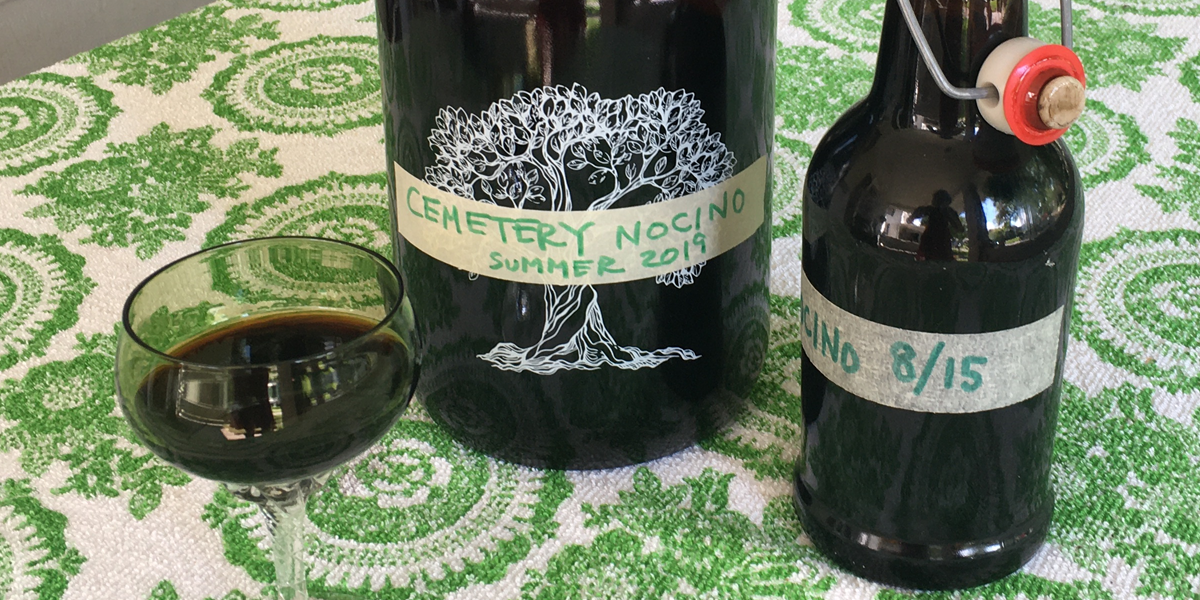I’m not sure how much this makes. I forgot to measure my yield. It’s a lot—enough to last you half a lifetime, or to make many gift-sized bottles. Don’t feel bound to the aromatics here. Omit them or switch them with more easily obtainable things like lemon peel, a cinnamon stick, or a modest spoonful of whole coffee beans. In keeping with the local theme, you should consider seeking out vodka from a regional distiller. I use Buckeye Vodka.
This nocino recipe is more traditional, and perhaps more suitable for people who are not foraging for every single ingredient. I’ve made it and added one whole star anise, too. This recipe is even more traditional, coming from Italy’s Ordine del Nocino Modense. Also, you don’t have to make your own Midwestern nocino. Columbus, Ohio’s Watershed Distillery sells one made with Ohio-grown walnuts.
And you can probably get me to give you a small bottle of mine. I have tons.
Ingredients
One 8” strip bark from a shagbark hickory tree
20 (or 21 or 23, if you want to be traditional) young green black walnuts, cut in half
One 6” sprig lemon verbena, with stem
Small handful dried mint leaves, or 2 handfuls fresh mint leaves
6 12” segments spicebush twig
6 dried spicebush berries, smashed with the flat side of a knife
4 thin strips dried black cherry bark
1-2 tbsp. dried sassafras root
2½ cups granulated sugar
1 liter vodka
Preparation
Hold the hickory bark with long metal tongs and char it lightly with a blowtorch, as if it were the inside of a bourbon barrel. Aim for a campfire smell, not pure carbon. You can also toast it in the oven (350 degrees, 30-45 minutes, or until lightly browned and aromatic), but the blowtorch is faster and more fun.
With a sharp knife, cut clean through the walnuts. It’s fun, and it sounds harder than it is, I promise. Their cross-sections look like little brains. Walnuts can stain work surfaces black (ah, so that’s why they are called black walnuts). If you’re concerned about stains, wear gloves and use a junky cutting board.
Drop the walnuts into a large, clean glass jar. I use an old one-gallon jar that previously held fruit salad. Add the herbs and twigs. It’s totally fine to bend or mangle them to get them to fit. In fact, it’s probably a good idea, because you’ll bruise them and release more of their flavor. Then drop in the remaining aromatics, plus the sugar. Pour the vodka over the top. Cover the mixture with a clean kitchen towel or cheesecloth, secured with a rubber band. A lot of the sugar will just sit on top and not dissolve, but that’s okay. It will dissolve eventually.
Stir once a day for 7 days. By the end, more of the sugar will have dissolved, and the mixture will have taken a frightful brown cast. Switch to a tight-fitting lid and continue aging for 2 months (I keep track of all this on a calendar, but it’s a good idea to label the jar with the date you began). A few times a week, give the jar a stir or a good jostle. Eventually, the liquid in the jar will turn almost black. It’s what you want.
Strain the liquid through a cheesecloth-lined strainer and pour into bottles for storage. Age for at least 6 months. At that point, it will probably taste horrible, and you will feel sad. Do not dump it out! Hide the bottles in a cool, dark place and forget about them for at least another 6 months. After that, the nocino will be at least palatable.
Forget about the bottles for another few years and the nocino will be a whole new deal—mellowed yet complex. Give the bottles away, enjoy small glasses as digestifs, pour a little over very good vanilla ice cream. You can even make cocktails with it.


